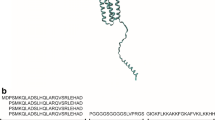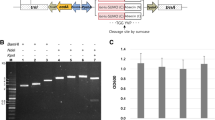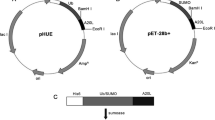Abstract
A novel strategy for constructing multiple joined genes of acidic partner-mediated antimicrobial peptide is described. This strategy allows the expression of antimicrobial peptide byEscherichia coli in a stable form and with high yield. Cecropin A (1–8)-melittin (1–10) (CAME) hybrid peptide was selected as a model of antimicrobial peptide. An acidic fragment from magainin intervening sequence was fused to the antimicrobial peptide as a partner to neutralize the lethal effects on the host cells. Multiple copies of the fusion peptide gene were tandemly linked and cloned into the expression vector pET21a. Multimers were expressed at high levels, reaching up to 36% of total cell proteins, and expression levels were proportional to the degree of multimerization. The fusion proteins were mainly expressed as inclusion bodies, probably owing to cysteine residues in the multimers. The target CAME peptide was obtained by cleaving the multimers with cyanogen bromide and purified by cation-exchange chromatography. Recombinant CAME peptide showed strong antimicrobial activities against both Gram-negative and -positive bacteria. These results might provide an efficient solution for high-level expression of various kinds of antimicrobial peptides that are toxic to the host.
Similar content being viewed by others
References
Kelley, K. J. (1996),Nat. Biotechnol.,14, 587–590.
Zasloff, M. (1987),Proc. Natl. Acad. Sci. USA 84, 5449–5453.
Zasloff, M. (1992),Curr. Opin. Immunol. 4, 3–7.
Shai, Y. and Oren, Z. (2001),Peptides 22, 1629–1641.
Piers, K. L., Brown, M. H., and Hancock, R. E. W. (1993),Gene 134, 7–13.
Callaway, J. E., Lai, J., Haselbeck, B., Baltaian, M., Bonnesen, S. P., Weickmann, J., Wilcox, G., and Lei, S. P. (1993),Antimicrob. Agents. Chemother. 37, 1614–1619.
Wade, D., Andreu, D., Mitchell, S. A., Silveira, A. M., Boman, H. G. (1992),Int. J. Pept. Protein Res. 40, 429–436.
Chan, R. Y. K., Palfree, R. G. E., Congote, L. F., and Solomon, S. (1994),DNA Cell Biol. 13, 311–319.
Lennick, M., Haynes, J. R., and Shen, S. H. (1987),Gene 61, 103–112.
Lee, J. H., Minn, I., Park, C. B., and Kim, S. C. (1998),Protein Expr. Purif. 12, 53–60.
Sambrook, J., Fritsch, E. F., and Maniatis, T. (1989),Molecular Cloning: A Laboratory Manual, 2nd ed., Cold Spring Harbor Laboratory Press, Cold Spring Harbor, NY.
Schagger, H. and von Jagow, G. (1987),Anal. Biochem. 166, 368–379.
Dathe, M., Nikolenko, H., Meyer, J., Beyermann, M., and Bienert, M. (2001),FEBS Lett. 501, 146–150.
Nutkins, J. C. and Williams, D. H. (1989),Eur. J. Biochem. 181, 97–102.
Michaelson, D., Rayner, J., Couto, M., and Ganz, T. (1992),J. Leukoc. Biol. 51, 634–639.
Liu, L. and Ganz, T. (1995),Blood 85, 1095–1103.
Yang, Y. H., Zheng, G. G., Li, G., Zhang, X. J., Cao, Z. Y., Rao, Q., and Wu, K. F. (2004),Protein Expr. Purif. 37, 229–235.
Zhang, L., Falla, T., Wu, M., Fidai, S., Burian, J., Kay, W., and Hancock, R. E. (1998),Biochem. Biophys. Res. Commun. 247, 674–680.
Shen, S. H. (1984),Proc. Natl. Acad. Sci. USA 81, 4627–4631.
Park, C. J., Lee, J. H., Hong, S. S., Lee, H. S., and Kim, S.C. (1998),Appl. Microbiol. Biotechnol. 50, 71–76.
Li, C., Ng, M. L. P., Zhu, Y., Ho, B., and Ding, J. L. (2003),Protein Eng. 16, 629–633.
Lee, J. H., Kim, M. S., Cho, J. H., and Kim, S. C. (2002),Appl. Microbiol. Biotechnol. 58, 790–796.
Lee, J. H., Kim, J. H., Hwang, S. W., Lee, W. J., Yoon, H. K., Lee, H. S., and Hong, S. S. (2000),Biochem. Biophys. Res. Commun. 277, 575–580.
Author information
Authors and Affiliations
Corresponding author
Rights and permissions
About this article
Cite this article
Wang, YQ., Cai, JY. High-level expression of acidic partner-mediated antimicrobial peptide from tandem genes inEscherichia coli . Appl Biochem Biotechnol 141, 203–213 (2007). https://doi.org/10.1007/BF02729062
Received:
Revised:
Accepted:
Issue Date:
DOI: https://doi.org/10.1007/BF02729062




